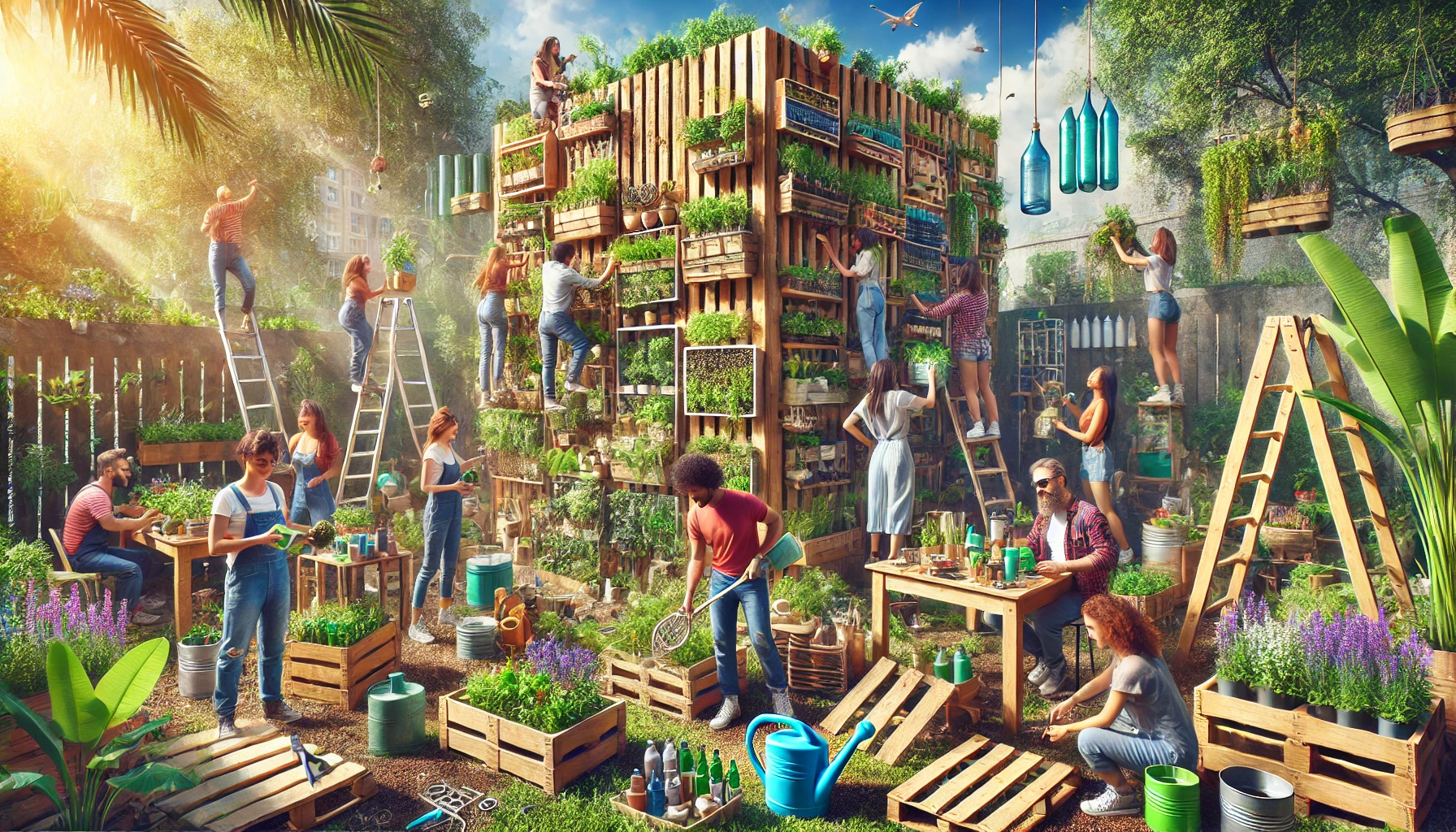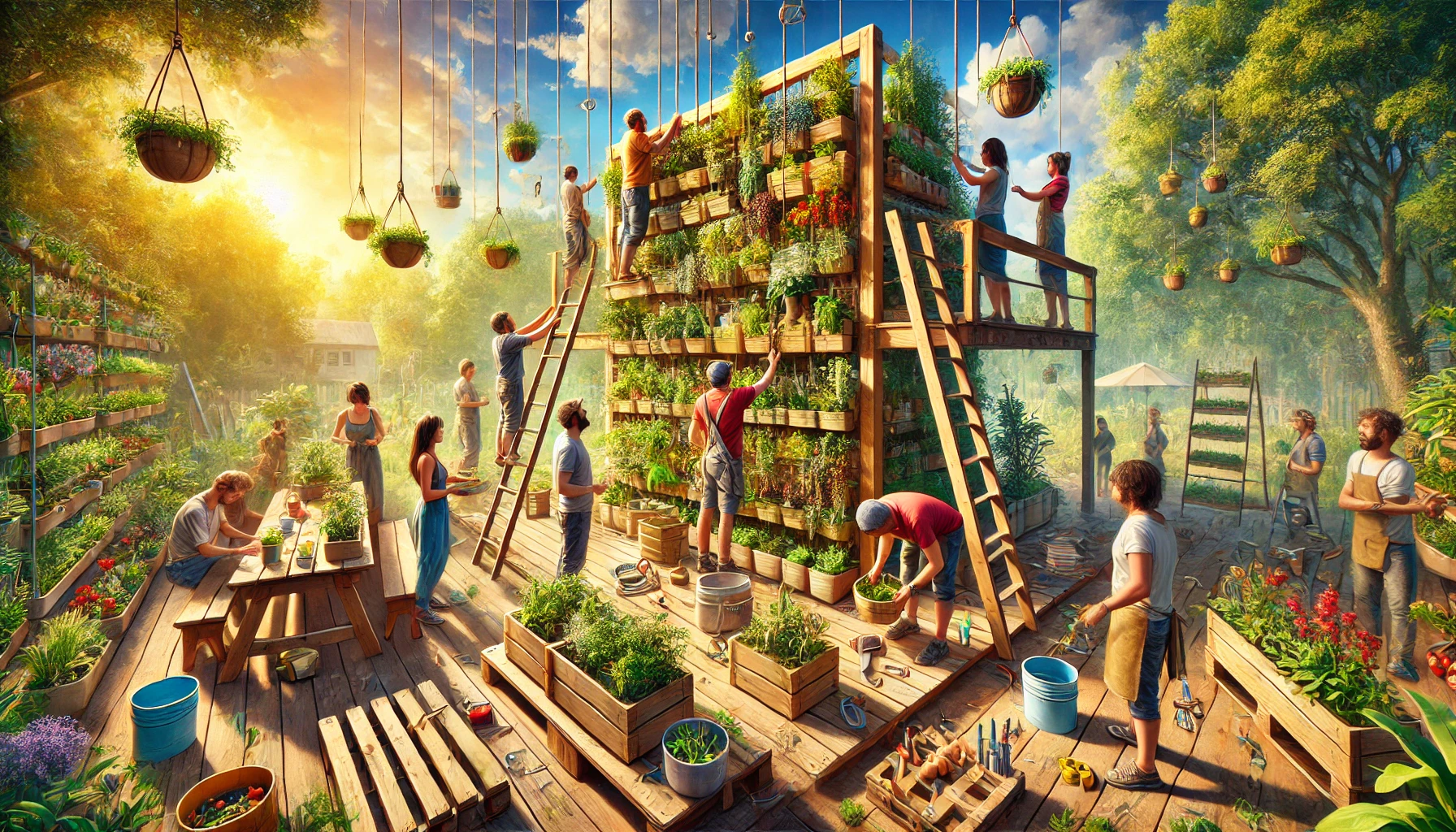Introduction to DIY Vertical Gardening Systems
In today’s world, where urban spaces are becoming increasingly cramped, the need to maximize living areas has never been more important. For gardening enthusiasts, this challenge brings a creative solution: DIY Vertical Gardening Systems.
These ingenious setups allow you to grow lush greenery, fresh vegetables, and vibrant flowers even in the smallest of spaces.
Whether you’re looking to beautify your apartment balcony or maximize your backyard’s potential, vertical gardening offers a practical and rewarding way to cultivate your love for plants.
Importance of Vertical Gardening in Urban Spaces
Vertical gardening has gained immense popularity, especially in cities where green spaces are limited. By growing plants upwards instead of outwards, you can transform walls, fences, and other vertical surfaces into thriving gardens.
Beyond aesthetics, vertical gardens improve air quality, insulate buildings, and contribute to urban biodiversity. It’s a sustainable and innovative approach to gardening that not only benefits you but also the environment.
Enter DIY Vertical Gardening Systems—a cost-effective, customizable solution to making the most of your available space.
Understanding the Basics: What is Vertical Gardening?
Definition and Brief History of Vertical Gardening
Vertical gardening refers to the practice of growing plants in vertically stacked layers or on upright surfaces.
This method dates back centuries, with early examples like the Hanging Gardens of Babylon showcasing the beauty and practicality of growing plants vertically.
Today, modern technology and innovative designs have made vertical gardening accessible to everyone.
Different Types of Vertical Gardening Systems
Vertical gardening systems come in various forms, depending on your needs, budget, and space. Some popular types include:
- Living Walls: Also known as green walls, these are panels of plants grown vertically using hydroponics or soil.
- Stacked Planters: Containers stacked atop one another, ideal for small-scale gardening.
- Trellises and Climbing Systems: Support structures for climbing plants like beans and vines.
- Hydroponic Towers: Systems that grow plants without soil, using nutrient-rich water instead.
Creating Your Own: How to Design a DIY Vertical Garden
Assessing Your Space and Sunlight Conditions
The first step in creating a DIY vertical garden is to evaluate your space. Consider factors like wall dimensions, available sunlight, and proximity to water sources. South-facing walls are ideal for maximum sunlight exposure, but even shaded areas can support certain plant types.
Choosing the Right Materials and Tools for Your Project
Materials and tools vary depending on your design, but common items include:
- Wooden pallets or trellises
- Hanging pots or recycled containers
- Mounting brackets and screws
- Gardening soil and fertilizer
- Basic tools like a drill, hammer, and measuring tape
Step-by-Step Guide to Building a Basic Vertical Garden
- Plan Your Design: Sketch your vertical garden layout, considering plant placement and irrigation needs.
- Prepare the Structure: Build or repurpose your base structure, ensuring it’s sturdy and weather-resistant.
- Install Irrigation: For larger setups, include a drip irrigation system to save time and water.
- Plant Your Garden: Choose plants suited to your space and arrange them according to their sunlight needs.
- Maintain Regularly: Water, prune, and fertilize your vertical garden to ensure it thrives.
Tips for Beginners
If you’re new to vertical gardening, start small. A simple hanging planter or a stack of pots can help you learn the basics before tackling larger projects. Experiment with low-maintenance plants like succulents or herbs to build confidence.
Plant Choices: What Grows Best in a Vertical Garden?
Overview of Suitable Plant Types for Vertical Gardens
When choosing plants for your vertical garden, consider their growth habits and requirements. Suitable options include:
- Vegetables: Lettuce, spinach, cherry tomatoes, and cucumbers
- Herbs: Basil, mint, parsley, and cilantro
- Flowers: Petunias, marigolds, and fuchsias
- Climbing Plants: Ivy, morning glories, and jasmine
Benefits of Choosing Certain Plants Over Others
Compact and fast-growing plants are ideal for vertical gardens. Herbs and vegetables, for example, provide a dual benefit of beauty and functionality, allowing you to enjoy fresh produce straight from your garden.
Considerations for Climate and Regional Growing Conditions
It’s essential to select plants suited to your local climate. Native species often thrive better and require less maintenance. Research your region’s growing conditions to ensure success.
Seasonal Planting Strategies
To keep your vertical garden productive year-round, plan for seasonal planting. Rotate crops based on the time of year, and consider using cold frames or protective coverings to extend the growing season for certain plants.
Maintenance Tips: Keeping Your Vertical Garden Healthy
Importance of Watering and Feeding Schedules
Regular watering is crucial for vertical gardens, as plants in containers tend to dry out faster. Establish a consistent schedule and use slow-release fertilizers to provide essential nutrients. Automated irrigation systems can be a game-changer for larger setups.
Pest Management for Vertical Gardens
Pests can be a challenge, but proactive management helps. Use natural remedies like neem oil or introduce beneficial insects like ladybugs to keep pests at bay. Regularly inspect your plants for signs of infestation to catch problems early.
Pruning and Harvesting Techniques
Prune plants regularly to promote healthy growth and prevent overcrowding. For edible gardens, harvest produce frequently to encourage continued production. Deadheading flowers can also enhance the appearance of ornamental vertical gardens.
Troubleshooting Common Issues
- Overwatering: Ensure proper drainage to prevent root rot.
- Nutrient Deficiencies: Supplement with fertilizers tailored to your plants’ needs.
- Structural Instability: Reinforce your garden structure to handle the weight of mature plants.
The Pros and Cons: Are There Any Drawbacks to Using Vertical Gardens?
Common Challenges and Limitations of Vertical Gardening
While vertical gardening offers numerous benefits, there are some drawbacks to consider:
- Limited root space for plants
- Potential overwatering or underwatering
- Structural limitations for large setups
- Increased initial setup costs for advanced systems
Strategies to Overcome Potential Drawbacks
- Use lightweight soil mixtures to reduce weight.
- Install proper drainage systems to prevent waterlogging.
- Regularly inspect and reinforce structures to ensure stability.
- Opt for drought-tolerant plants to reduce watering needs.
Long-Term Benefits vs Short-Term Challenges
Despite initial challenges, vertical gardening provides long-term rewards such as fresh produce, improved aesthetics, and environmental benefits, making it a worthwhile investment.
Budget Planning: How Much Does it Cost to Build a Vertical Garden?
Breakdown of Potential Expenses
The cost of a vertical garden depends on its size and materials. Typical expenses include:
- Structure Materials: $20-$100
- Plants: $10-$50
- Soil and Fertilizer: $20-$40
- Irrigation Systems: $30-$100
Cost-Saving Tips and DIY Alternatives
- Repurpose household items like old pallets, bottles, or gutters.
- Grow plants from seeds instead of purchasing seedlings.
- Opt for hand-watering instead of automated systems to reduce initial costs.
Evaluating the Return on Investment
Vertical gardens can save money in the long run by providing fresh produce and reducing grocery bills. Additionally, they enhance property value and contribute to a healthier environment.
Long-Term Maintenance Costs
Factor in ongoing expenses like soil replenishment, pest control, and seasonal planting. Budgeting for these costs ensures your garden remains vibrant and productive year after year.

Innovative Ideas: Creative DIY Vertical Gardening Systems
Exploring Unique Vertical Garden Designs
Unleash your creativity by experimenting with:
- Hanging shoe organizers for small herb gardens
- Vertical PVC pipe planters for compact spaces
- Wall-mounted pots arranged in artistic patterns
- Using reclaimed wood or metal for an industrial look
Inspiration from Successful Urban Vertical Gardens
Look to urban gardening pioneers for ideas. Cities like Singapore and Paris boast breathtaking green walls that inspire gardeners worldwide. Community gardens and urban farming projects often showcase innovative vertical gardening techniques.
Repurposing Everyday Items
Transform common items like wooden crates, old ladders, or even unused furniture into functional and eye-catching vertical garden structures. Use recycled bottles or tin cans as individual planters for a budget-friendly and eco-conscious design.
Conclusion: Embracing the Vertical Garden Lifestyle
The rise of DIY Vertical Gardening Systems highlights a growing awareness of sustainable living. By adopting vertical gardening, you not only beautify your surroundings but also contribute to a greener planet.
Whether you’re a seasoned gardener or a beginner, starting your own vertical garden is an exciting and fulfilling journey. So, roll up your sleeves, gather your materials, and transform your space into a thriving oasis. The future of urban gardening starts with you!
Vertical gardening is more than a trend; it’s a lifestyle choice that aligns with environmental stewardship, creativity, and the joy of nurturing life.
From improving your mental well-being to providing fresh produce, the benefits of vertical gardening are as varied as the plants you can grow. Dive into this rewarding practice and watch your efforts flourish—both literally and figuratively.


Vertical gardens are critical in these days because we must start to growing our own food again. With all these things coming out, all the chemicals in food, we must have a vertical garden. I’ve known a woman who grew a vertical garden in her yard and she was growing tomatoes and cucumbers. They were really nice! Thanks for sharing the best tips for all of us to get our own vertical gardens!
You’re absolutely right—vertical gardens are such a great solution for growing clean, chemical-free food! It’s inspiring to hear about that woman’s success with tomatoes and cucumbers. Thanks for sharing, and I’m glad you found the tips helpful!